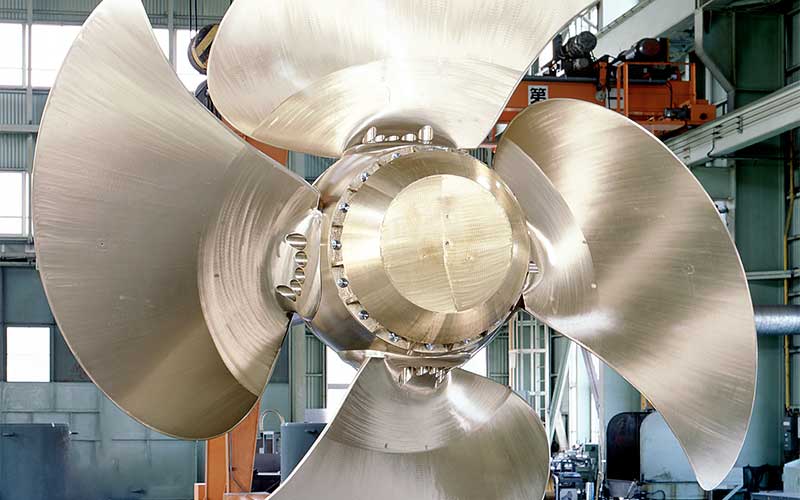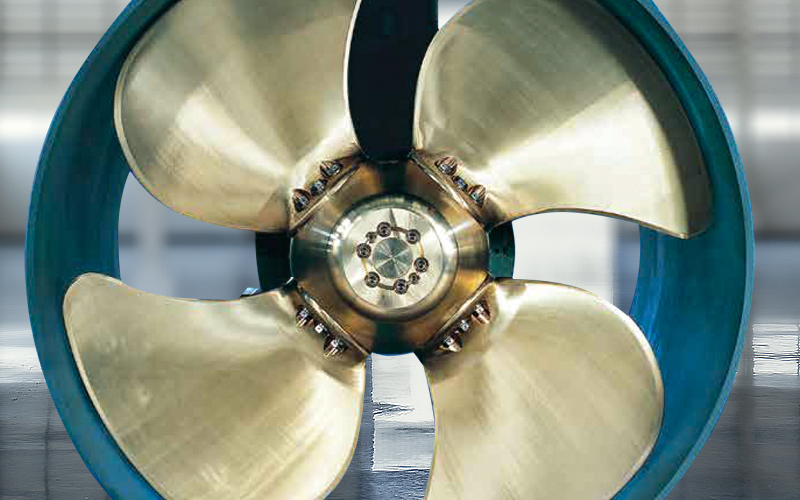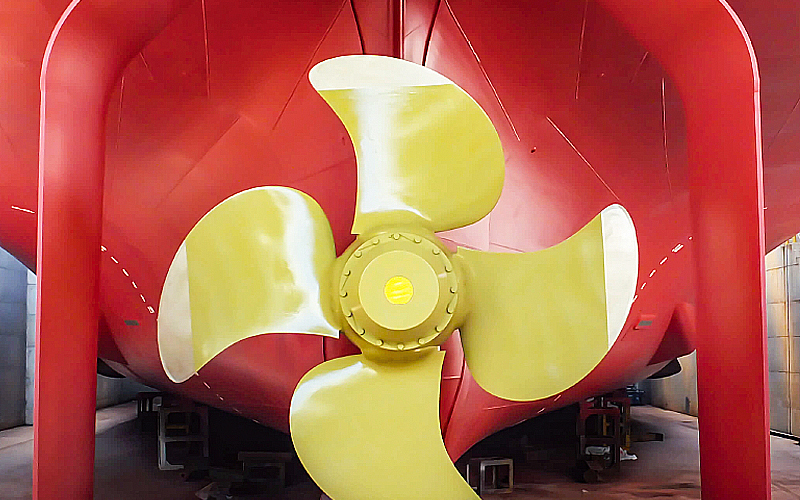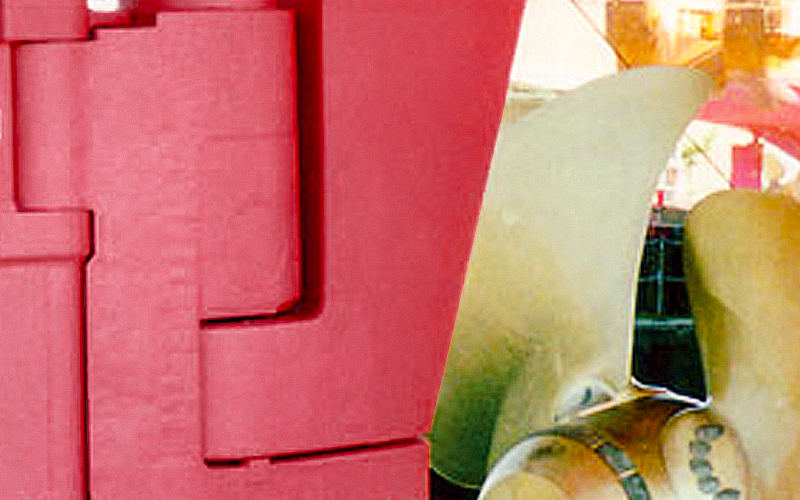Safe sailing and energy saving with
controllable pitch propellers
Excellence in Ship Control for Increased Safety
Economy Improved by Control Optimized for Operational Conditions
Configuration of Environmentally Friendly Drive Systems
Excellence in Ship Control Performance
Controllable pitch propellers make it is easy to secure necessary speeds for forward and backward operations merely by controlling the pitch. They cover a complete range of operations including full-speed sailing, low-speed sailing, and stop and backward sailing. These may be likened to automatic transmission gears for cars.
Controllable pitch propellers allow the ship speed to be freely changed in a non-step manner by simply controlling the propeller pitch to ensure all types of ship operation, ranging from full-speed forward sailing to full-speed backward sailing.
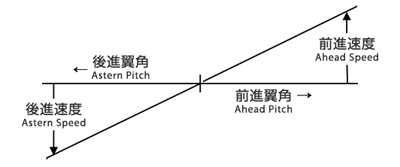
With fixed pitch propellers, minimum revolutions of the main engine are limited. The diagram below shows the ship speed that may be continuously maintained. Fixed pitch propellers do not support continuous operation at low speed.
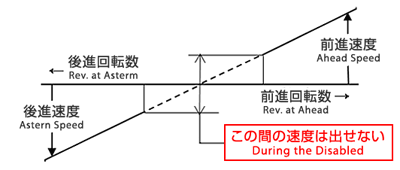
Moderate Operation for Improved Economy
Output required for propulsion varies constantly depending on the freight, sea conditions such as trailing or contrary wind and tide, fouling on the bottom of the ship and other factors.
With controllable pitch propellers, the pitch is controlled according to the load conditions to ensure reasonable operation of the main engine.
As a ship carries more cargo and as its draft is deeper, ship resistance increases. Contrary wind or tide necessitates higher output for propulsion for maintaining ship speed.
Controllable pitch propellers allow the main engine to operate in a low load state in which fuel efficiency is high by controlling the propeller pitch according to the situation. They consequently cut energy consumption by about 5-10% and improve economy.
Controllable pitch propellers make it easy to make effective and optimal use of the characteristics of the main engine in line with the ship’s purpose, the operational conditions and the load conditions, and therefore conserve energy. For this purpose, many different control systems are available.
Automatic Load Control (ALC)
This system automatically controls the propeller pitch to maintain the load at the target level set on the basis of the output and fuel consumption characteristics of the main engine.
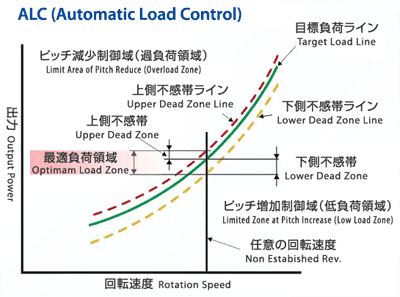
Automatic Speed Control (ASC)
This system automatically keeps the ship speed at a predetermined level by regulating the propeller pitch while maintaining the revolutions of the engine or by controlling the revolutions while maintaining the pitch in response to changes in ship speed.
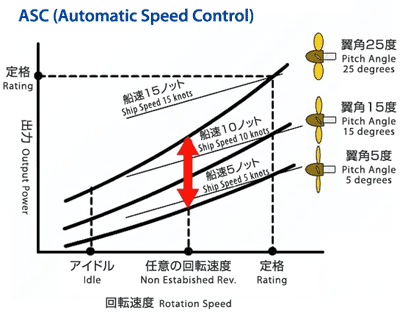
Program Control (PGM)
This system ensures reasonable operation of the engine according the predetermined control procedures for the optimal propeller pitch and revolutions even if the operator gives the command for drastic pitch control.
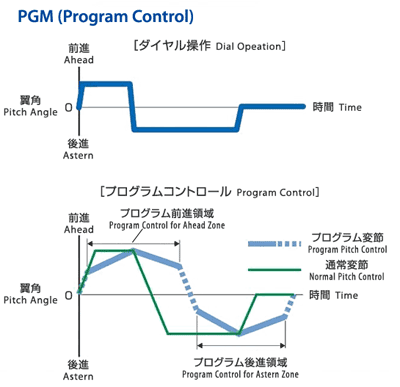
Environmentally Friendly Propulsion Systems
A controllable pitch controller enables the main engine to operate at constant revolution solely by pitch control. This paves the way for building a drive system with a fuel-efficient main engine to drive the power generator and hydraulic equipment. It also eliminates the need to operate an auxiliary engine to cut fuel consumption, and ultimately results in an environmentally friendly propulsion system with reduced CO2 and nitrogen oxide (NOx) emissions from the main engine.
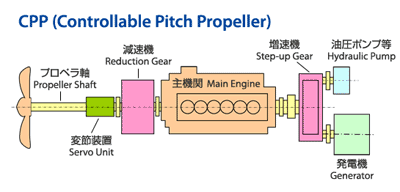
Advanced Quick Stop Performance for Enhanced Safety
To quickly stop the ship with a controllable pitch propeller, the operator need only shift from a forward propeller pitch to a reverse one or vice versa without changing revolutions. The ship can be stopped in a short time at a short distance, half that of fixed pitch propellers. A shorter stopping distance at the time of quick stop improves ship control and safety during emergency situations.
A fixed pitch propeller for quick stopping takes the following control steps.
- Reduced revolutions
- Clutch control (from forward to neutral, then to reverse)
- Increased revolutions
Because of the ship’s momentum it takes some time to reduce propeller revolutions and to increase revolutions for reverse movement. Therefore a longer stopping distance is needed.
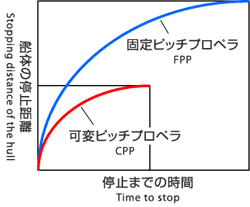
In narrow waterways or ports with many ships, controllable pitch propellers increase safety as they ensure unfailing ship collision prevention and other ship stop control during emergency situations.
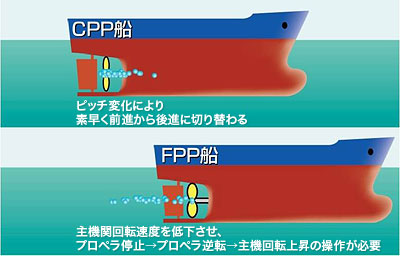
Smart installation of controllable pitch propellers brings the following benefits.
- Ship control becomes easier and safety is improved.
- Fuel consumption lowers and economy increases.
- Environmentally friendly propulsion system is constructed with improved fuel efficiency and lower CO2 and nitrogen oxide (NOx) emissions.
- Features of controllable pitch propellers are also applied to electric propulsion ships.
Brochure Download
Brochure can be downloaded in PDF Profile.

